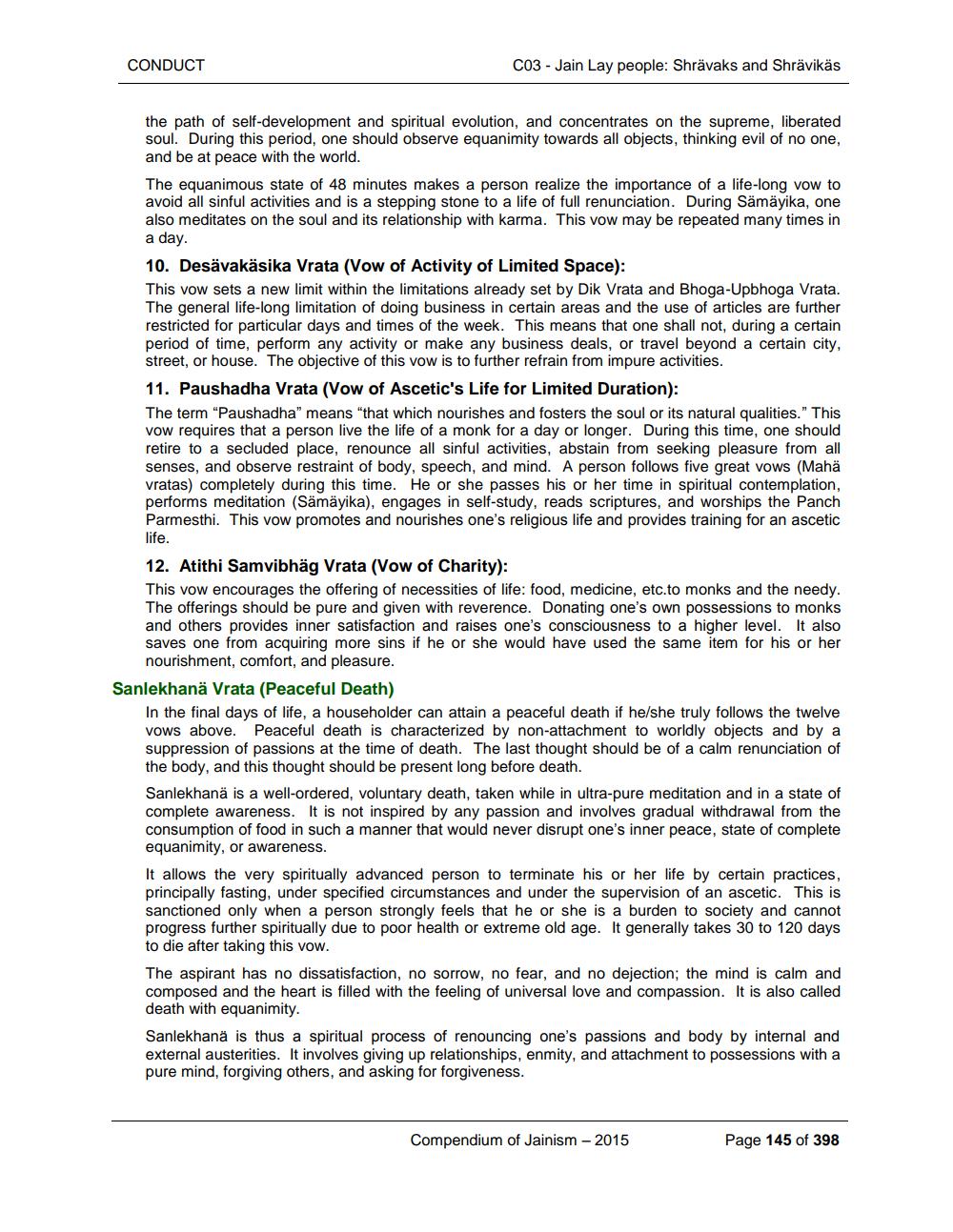________________
CONDUCT
C03 - Jain Lay people: Shrävaks and Shrävikäs
the path of self-development and spiritual evolution, and concentrates on the supreme, liberated soul. During this period, one should observe equanimity towards all objects, thinking evil of no one, and be at peace with the world.
The equanimous state of 48 minutes makes a person realize the importance of a life-long vow to avoid all sinful activities and is a stepping stone to a life of full renunciation. During Sämäyika, one also meditates on the soul and its relationship with karma. This vow may be repeated many times in a day.
10. Desävakäsika Vrata (Vow of Activity of Limited Space):
This vow sets a new limit within the limitations already set by Dik Vrata and Bhoga-Upbhoga Vrata. The general life-long limitation of doing business in certain areas and the use of articles are further restricted for particular days and times of the week. This means that one shall not, during a certain period of time, perform any activity or make any business deals, or travel beyond a certain city, street, or house. The objective of this vow is to further refrain from impure activities.
11. Paushadha Vrata (Vow of Ascetic's Life for Limited Duration):
The term "Paushadha" means "that which nourishes and fosters the soul or its natural qualities." This vow requires that a person live the life of a monk for a day or longer. During this time, one should retire to a secluded place, renounce all sinful activities, abstain from seeking pleasure from all senses, and observe restraint of body, speech, and mind. A person follows five great vows (Mahä vratas) completely during this time. He or she passes his or her time in spiritual contemplation, performs meditation (Sämäyika), engages in self-study, reads scriptures, and worships the Panch Parmesthi. This vow promotes and nourishes one's religious life and provides training for an ascetic life.
12. Atithi Samvibhäg Vrata (Vow of Charity):
This vow encourages the offering of necessities of life: food, medicine, etc.to monks and the needy. The offerings should be pure and given with reverence. Donating one's own possessions to monks and others provides inner satisfaction and raises one's consciousness to a higher level. It also saves one from acquiring more sins if he or she would have used the same item for his or her nourishment, comfort, and pleasure.
Sanlekhanä Vrata (Peaceful Death)
In the final days of life, a householder can attain a peaceful death if he/she truly follows the twelve vows above. Peaceful death is characterized by non-attachment to worldly objects and by a suppression of passions at the time of death. The last thought should be of a calm renunciation of the body, and this thought should be present long before death.
Sanlekhanä is a well-ordered, voluntary death, taken while in ultra-pure meditation and in a state of complete awareness. It is not inspired by any passion and involves gradual withdrawal from the consumption of food in such a manner that would never disrupt one's inner peace, state of complete equanimity, or awareness.
It allows the very spiritually advanced person to terminate his or her life by certain practices, principally fasting, under specified circumstances and under the supervision of an ascetic. This is sanctioned only when a person strongly feels that he or she is a burden to society and cannot progress further spiritually due to poor health or extreme old age. It generally takes 30 to 120 days to die after taking this vow.
The aspirant has no dissatisfaction, no sorrow, no fear, and no dejection; the mind is calm and composed and the heart is filled with the feeling of universal love and compassion. It is also called death with equanimity.
Sanlekhanä is thus a spiritual process of renouncing one's passions and body by internal and external austerities. It involves giving up relationships, enmity, and attachment to possessions with a pure mind, forgiving others, and asking for forgiveness.
Compendium of Jainism - 2015
Page 145 of 398




